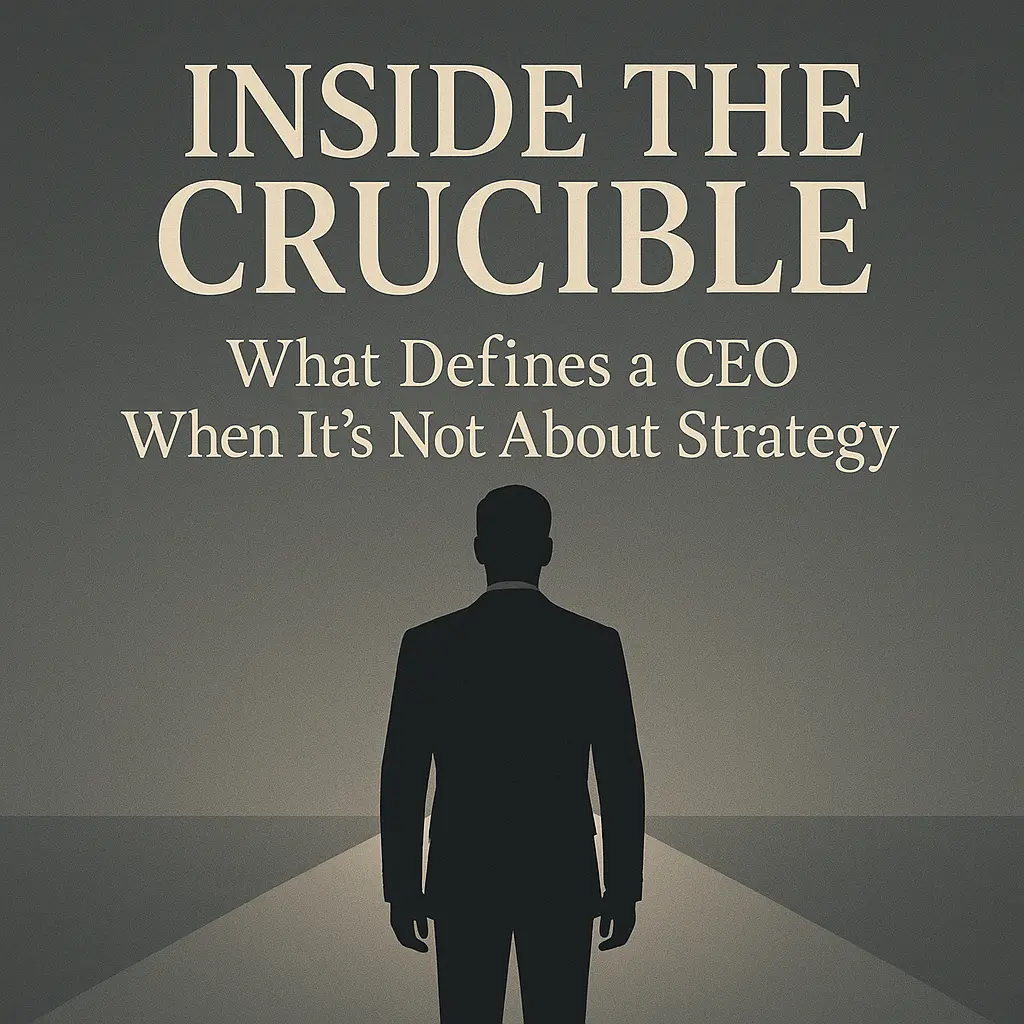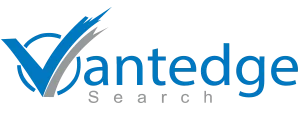View From The Top

Rajesh Khanna,
President,
Vantedge Search
At Vantedge Search, we’ve long believed that leadership is not proven at the point of ascent, but in the moments where risk is personal and outcomes uncertain. As you explore this edition’s insights—from the boardroom reset at Sony to the career playbook for stepping into senior roles—we invite you to look beyond the titles and timelines. Look instead at how today’s leaders earn trust not by outrunning disruption, but by standing still when it counts.
Inside the Crucible: What Defines a CEO When It’s Not About Strategy

The defining moments in a CEO’s life rarely arrive with the weight of the ceremony. There is no red light that blinks above the boardroom, no strategic offsite that foreshadows the most important decisions of their tenure. Instead, these moments surface quietly—in a breath held too long before a difficult conversation, in the quiet realization that doing the right thing may cost more than expected, or in the knowledge that no one else in the building can make this call.
We tend to admire leaders for what they build: bold visions, sharp pivots, breakthrough innovations. But beneath all of that lies a different kind of leadership—one that doesn’t revolve around expansion plans or AI deployment, but around presence. When strategy runs out and the next move isn’t in the playbook, what defines a CEO is not what they do, but how they carry the moment.
Pressure in 2025 is relentless. According to BCG, 40% of CEOs admit they feel unprepared for the kinds of market shocks they’re already facing. Cost reduction has emerged as the top strategic priority this year, and 86% of CEOs plan to invest in AI or advanced analytics. On paper, these numbers read like action plans.
But in practice, they signal turbulence—conditions where leaders must cut deep, move fast, and still manage to preserve morale and clarity. Behind every decision to restructure, to pivot or pause, there are people waiting. Watching. Wondering how to make sense of what happens next.
And it’s there—in the raw tension between performance and humanity—that real leadership is tested.
What sets apart those who rise is not tactical agility or visionary flair. It is their ability to stay calm in the noise, to communicate with honesty in the absence of certainty, and to choose discomfort when it’s the only path to integrity. The CEOs who earn quiet respect aren’t always the loudest in the room. They’re the ones who take the heat instead of redirecting it and make room for consequences instead of covering them with confident veneers.
There’s a subtlety to this kind of leadership. It doesn’t show up in quarterly reports. It’s the clarity in a message delivered without sugarcoating. The pause before a difficult call, taken not out of hesitation but out of reverence for its impact. The willingness to be unpopular when the company needs direction more than validation.
In recent conversations across the leadership space, one truth recurs: the hardest moments aren’t always the ones that look hardest from the outside. They’re the ones that leave no one else to blame, no time to deflect, and no reward for choosing right over easy. They’re the ones that ask the CEO to step out from behind the data and offer something more difficult: emotional steadiness, moral clarity, and personal risk.
These aren’t moments of execution. They’re moments of exposure. And they don’t build leaders. They reveal them.
In a world increasingly shaped by systems and strategy, the most important thing a CEO can bring to the table may be something deeply analog: themselves, fully present and accountable. When the plan breaks, when the room gets quiet, and when everyone is waiting for someone to go first—that’s the crucible.
And the leaders who step into it, unflinching, are the ones who end up leaving more than a business behind. They leave a standard.

For more information on Vantedge Search, please contact us. We look forward to hearing from you.
Expert's Corner –
What's Trending?
Insights from Industry Leaders on Leading with Clarity, Cohesion, and Credibility
Not all leadership makes headlines—and that’s often a sign it’s working. While the business world chases disruption and bold declarations, a quieter form of leadership is taking shape—rooted in clarity, steadiness, and substance. This week, we explore how three industry leaders—at Intel, Sony, and Volvo—are redefining what it means to lead in uncertain times. Their stories aren’t about grand pivots or sweeping promises, but about the power of showing up with intent, integrity, and long-term conviction.

Hiroki Totoki, CEO, Sony
Sony CEO Hiroki Totoki’s leadership philosophy centers on cohesion, not disruption. In his first message, he emphasized a strategy of internal synergy—connecting Sony’s diverse businesses in gaming, music, pictures, and imaging to create value that exceeds the sum of their parts. Rather than pivoting toward noise or novelty, Totoki focuses on deepening what Sony already does well: high-impact IP, global expansion of creative content, and technological precision in entertainment hardware.
Totoki’s long-term vision is built on partnership and emotional resonance—what Sony calls Kando. He speaks not of reinvention, but of steady evolution, where creativity and technology converge to empower both creators and fans. His tone is measured, but his intent is bold: to grow by aligning around purpose, not hype. It’s a quiet but firm stance that implies leadership grounded in presence, patience, and clarity.
Håkan Samuelsson, CEO, Volvo Cars
Volvo Cars is navigating a volatile landscape marked by geopolitical headwinds, technological upheaval, and recalibrated ambitions in electrification. After stepping back from its bold all-electric-by-2030 timeline and divesting from Polestar, the company now faces a more complex, less linear path forward. Against this backdrop of uncertainty, the board has opted not for disruption, but for steadiness—bringing back former CEO Håkan Samuelsson for a two-year term to guide the company through this pivotal phase.
Samuelsson, who led Volvo from 2012 to 2022, returns with a mandate rooted in stability and execution. “I have deep respect for the challenges ahead,” he said, pointing to market demands, strategic discipline, and leadership development as priorities. His reappointment signals a back-to-basics approach—grounded in industrial experience and operational focus—as Volvo works to adapt in real time to trade tensions, shifting EV economics, and internal transformation. As board chair Eric Li put it: “His experience and steady hand are exactly what is needed.”

Lip-Bu Tan, CEO, Intel
At Intel’s Vision 2025 conference, CEO Lip-Bu Tan didn’t posture with certainty—he met the moment with clarity. Speaking candidly about Intel’s recent struggles, from missed technological milestones to a declining market position against rivals like TSMC and Samsung, Tan set a tone rare in an industry often defined by future hype. “There are areas we have fallen short of your expectations,” he acknowledged. And with that, he stepped into a leadership stance not built on charisma, but on credibility.
Tan’s message wasn’t just about strategy—it was about presence. He didn’t deflect, reframe, or bury the past under buzzwords. Instead, he offered a steady recalibration: “My motto is simple: underpromise and overdeliver.” With that, he shifted the conversation from recovery to responsibility. By recommitting to customer trust and setting a course toward engineering excellence, he embodied a kind of leadership that prioritizes integrity over noise.
What followed was not a reinvention for applause, but a reset grounded in values. Tan laid out a clear vision: rebuild Intel into an “engineering-focused company,” rooted in talent, culture, and accountability. He spoke of empowerment, of unleashing the creativity of engineers, and of doing the hard work to reposition Intel in critical areas like AI and cloud. “We are committed to a journey of reinvention,” he said—not as a headline, but as a contract.
In a time when CEOs are under relentless pressure to deliver performance amid uncertainty, Tan’s approach offers something rare: composure in the face of complexity. His remarks echo the kind of leadership that doesn’t just survive the crucible but is revealed by it.
Executive Movements:
Leadership Transitions & Strategic Pivots
CEO Movements
End of an Era: Warren Buffett to Step Down as Berkshire CEO in 2025
After six decades at the helm, Warren Buffett will step down as CEO of Berkshire Hathaway at the end of 2025, officially naming Greg Abel as his successor. Buffett, 94, made the announcement at Berkshire’s annual meeting, stating Abel will have the “final word,” though he may stay involved in limited ways. Buffett emphasized he has “zero” intention of selling his Berkshire shares, underscoring his confidence in the company’s future under Abel’s leadership. This marks the close of a legendary chapter in American business—one that turned a struggling textile firm into a $1.16 trillion powerhouse.
Kohl’s Ousts CEO Ashley Buchanan Over Ethics Violations
Kohl’s has terminated CEO Ashley Buchanan “for cause” after an external investigation revealed undisclosed conflicts of interest tied to vendor dealings. Buchanan, who served just four months, allegedly directed business toward a vendor connected to a personal relationship—without disclosing it—violating company ethics policies. Michael Bender steps in as interim CEO while the retailer searches for new leadership amid ongoing performance struggles and a critical turnaround effort.
Craig Donohue Named CEO of Cboe Global Markets Amid Record Q1 Earnings
Cboe Global Markets has appointed industry veteran Craig Donohue as its new CEO, effective May 7, following Fredric Tomczyk’s decision to step down. Donohue brings decades of leadership experience from OCC and CME Group.
NXP CEO Kurt Sievers to Retire; Rafael Sotomayor Named Successor
NXP Semiconductors has announced that CEO Kurt Sievers will retire by year-end, with longtime executive Rafael Sotomayor stepping in as president immediately and CEO in October.
AEON Biopharma Names Rob Bancroft as CEO to Lead Next Phase of Growth
AEON Biopharma has appointed industry veteran Rob Bancroft as President and CEO, effective April 29, 2025. With 25+ years in life sciences and deep experience in the botulinum toxin space, Bancroft steps in to advance AEON’s ABP-450 biosimilar program targeting BOTOX’s therapeutic market. Former CEO Marc Forth will remain on the board.
Discord Appoints Former Activision Exec Humam Sakhnini as New CEO
Discord has named Humam Sakhnini, former Vice Chairman of Activision Blizzard, as its new CEO, effective April 28. Co-founder Jason Citron will step down after nearly a decade, moving into an advisory role while CTO Stan Vishnevskiy stays on.
Harley-Davidson CEO Jochen Zeitz to Retire Amid Ongoing Turnaround Effort
Harley-Davidson CEO Jochen Zeitz will step down in 2025 after a five-year run focused on reviving the iconic motorcycle brand. Zeitz led the “Hardwire” strategy to prioritize high-margin products and modernize the brand, but persistent weak demand and market headwinds have stalled momentum. The board has begun a CEO search, with Zeitz set to remain until a successor is appointed.
Puma Names Ex-Adidas Exec Arthur Hoeld as CEO Amid Strategic Struggles
Puma has appointed former Adidas global sales chief Arthur Hoeld as its new CEO, effective July 1, following the early exit of Arne Freundt over strategic differences.
WilliamsMarston Promotes Sanjay Ramaswamy to CEO Amid Strategic Growth Push
WilliamsMarston has named Sanjay Ramaswamy as its new CEO, effective immediately. Previously COO, Ramaswamy brings leadership experience from EY, J&J, AlixPartners, and McKinsey. Co-founders Landen Williams and Jon Marston will transition to Co-Chairmen.
CFO Movements
- Volvo Cars appoints Fredrik Hansson as CFO, succeeding Johan Ekdahl amid ongoing executive reshuffles and market headwinds.
- Macy’s names Thomas J. Edwards as COO and CFO, with key leadership realignments to support its “Bold New Chapter” growth strategy.
- Paragon Space Development appoints Nina Grigsby as CFO to lead financial strategy amid growing demand in the global space economy.
- Cintas names Scott Garula as incoming CFO, succeeding retiring EVP & CFO Mike Hansen, effective May 31, 2025.
- Allison Transmission appoints Scott Mell as CFO and Treasurer, effective April 14, succeeding COO Fred Bohley in the finance role.
- Lockheed Martin appoints Evan Scott as CFO and Senior VP, succeeding Jesus Jay Malave amid ongoing tech advancements in multi-domain operations.
CIO/CTO Movements
- Coke Florida appoints Gerald Charles, Jr. as CIO, while Terrence Gee transitions to Advisor focusing on warehouse automation.
- Sprinklr appoints Sanjay Macwan as CIO to lead global IT, security, and data strategy amid continued platform transformation.
- The Hartford appoints Shekar Pannala as CIO and Jeffery Hawkins as Chief Data, AI & Operations Officer in a strategic tech leadership reshuffle.
- BayPort Credit Union appoints Jonathan Harrell as CIO to lead its IT strategy and innovation, following the retirement of longtime tech chief Denise McRoberts.
- Invest Bank appoints Narinder Auluck as its first-ever Chief Technology Officer to drive digital strategy and IT governance.
- Medius appoints John Seery as Chief Technology Officer to lead AI-driven innovation and enhance value in spend management solutions.
Insights: Inferring the why
The latest set of CEO transitions across industries—from legacy giants like Berkshire Hathaway to emerging biotech players—signals more than routine leadership change. Companies are recalibrating their executive benches to address evolving business realities: aging founder exits, ethical scrutiny, strategic pivots, and digital-first operating models. These moves reflect deeper shifts in corporate priorities shaped by economic uncertainty, industry disruption, and stakeholder demands.
- Generational Handoffs Are Reframing Legacy Leadership
Warren Buffett’s decision to step down as CEO of Berkshire Hathaway after six decades marks a generational milestone in corporate stewardship. Companies with long-standing leadership, including Harley-Davidson and Discord, are entering a phase where founder figures or legacy CEOs are transitioning out—either gradually or symbolically. These shifts signal an era where culture preservation must coexist with operational renewal.
- Governance Failures Are Triggering Abrupt CEO Exits
Kohl’s dismissal of Ashley Buchanan for ethics violations underlines rising accountability expectations for top executives. As scrutiny from boards and stakeholders intensifies, the margin for ethical missteps continues to narrow. Organizations are moving swiftly to protect brand integrity, even amid ongoing turnarounds—demonstrating that culture and compliance are no longer secondary to performance.
- Internal Promotions Reflect Demand for Continuity in Uncertain Markets
Several CEO appointments—such as Rafael Sotomayor at NXP and Sanjay Ramaswamy at WilliamsMarston—were internal elevations. This trend shows that companies navigating market volatility or strategic transitions prefer known quantities who understand institutional dynamics, rather than external disruptors. It also helps stabilize investor confidence and reduces ramp-up time.
- Industry Expertise is Being Prioritized Over Traditional CEO Profiles
Whether it’s AEON Biopharma tapping Rob Bancroft from the therapeutics space or Discord appointing gaming veteran Humam Sakhnini, companies are seeking leaders with deep sectoral experience to address specialized challenges. This suggests a growing preference for operationally fluent executives who can drive product relevance and competitive positioning within niche markets.
- Founders Are Stepping Back, But Not Away
At both Discord and WilliamsMarston, founders are transitioning to advisory or chair roles while new CEOs take the reins. This “founder-to-advisor” pathway enables continuity without impeding change. It reflects a maturing governance model where leadership can evolve without severing institutional memory or diluting strategic vision.
Behind every leadership change lies a calculated bet: that the right mix of insider insight, ethical clarity, and sector fluency can future-proof a company. These aren’t just successions—they’re strategic signals about where industries are heading, and how fast they plan to get there.
There’s no formal curriculum for becoming a CEO
By the time you reach the upper rungs, you’re expected to already know. But what separates those who move up from those who step in—truly and fully—is shaped outside the spotlight. The habits below weren’t designed for visibility. They were built for gravity.
- Don’t confuse decisiveness with speed.
You’re not paid to react—you’re paid to discern. Let silence do some work before you speak into the noise.
Pacing is a leadership signal. If you move too fast, people assume you’re protecting ego or avoiding scrutiny. But if you move with just enough pause to show you’re holding weight—not stalling—you earn trust. The discipline isn’t about indecision. It’s about allowing space for others to surface what you might miss. Especially in tense environments, the best leaders build credibility not by having answers first, but by asking questions that weren’t yet on the table.
- Take fewer oxygen masks. Offer more.
When the room gets tight, weak leaders grab more authority. Strong leaders create oxygen for others—even as their own runs low.
At senior levels, it’s not about being composed. It’s about being consciously unshielded. In moments of strain—board pressure, public scrutiny, internal resistance—the instinct is to protect: fewer meetings, tighter messages, more gatekeeping. But what defines leadership isn’t how well you contain your stress. It’s whether you still make room for someone else to contribute under that stress. The most trusted CEOs are the ones who stay porous—who still invite challenge, still mentor, still ask real questions—when they least have to.
- Build trust when you don’t need it.
The worst time to build trust is when you need it to land a decision.
Real authority isn’t built in high-stakes moments—it’s revealed there. By then, it’s too late to shape how people hear you. The CEOs who hold sway in the room are the ones who’ve been consistent long before it mattered: the ones who returned the tough call, stayed transparent when they could’ve withheld, or gave credit when no one was watching. Quiet consistency compounds. One missed moment doesn’t cost you trust. But a dozen unremarkable interactions where people walk away clearer, safer, or seen? That’s your leadership equity—and in crisis, it buys you the benefit of the doubt you can’t ask for.
- Earn the right to say less.
If you’ve missed before, stop selling belief. Start rebuilding proof.
The biggest test of leadership isn’t making bold promises—it’s restoring trust when you’ve missed one. That requires a shift from momentum to mechanics: fewer messages, tighter scopes, visible delivery. You can’t reframe your way out of a performance gap. What people want to see isn’t your optimism—it’s your operating system. The leaders who recover from credibility hits aren’t quieter because they’re humbled. They’re quieter because they’re locked in.
- Don’t reinvent. Reintegrate.
Not every challenge calls for reinvention. Sometimes, the smarter move is to make the pieces fit better.
There’s a bias toward big moves—new strategies, new markets, new signals to the board. But strong leadership often looks quieter: connecting what’s already there. That means pulling value from the overlooked, creating alignment across silos, and compounding momentum instead of chasing novelty. It’s less exciting, but more powerful. The leaders who win aren’t always the ones who change the game. They’re the ones who see the game clearly—and tighten what others overlook.
- Step back in when it’s no longer about you.
There’s a moment in every career when the role is less about ambition—and more about obligation.
The mark of a seasoned leader isn’t what they walk toward when everything’s aligned—it’s what they return to when the timing is wrong, the politics are messy, and the outcomes are uncertain. There’s no spotlight in those moments. No narrative win. Just a question: Will you hold the weight again, because no one else can? When your name carries more trust than excitement, and you still choose to lead—that’s not legacy. That’s leadership.
Conclusion
These aren’t tools. They’re tells.
In pressure rooms, these are the signals boards, investors, and teams clock—often unconsciously—before deciding who to trust. You don’t need all six right now. But you do need to know which one your next decision will test.


